|
"Adding a bird bath to a garden area creates a decorative feature while promoting conservation of wild birds and other wild creatures. Bird baths create a water source for birds and other wild visitors to a garden. Knowing how to landscape around a bird bath can help you safely provide for visiting birds while creating a beautiful display in your garden. Proper Location for a Bird Bath A spot near trees and bushes is ideal for your bird bath. This location will make it more accessible to the wild birds that will visit and make use of the feature. Placing the bird bath in a sunny location gives you a large variety of plant possibilities around the bird bath but an area that receives a combination of sun and partial shade throughout the day would be an ideal choice. A Foundation for Your Bird Bath A paving stone is a good choice to set the bird bath on. Placing your bird bath on a paving stone will provide stability and a flat surface as well as block out some of the weeds directly against the base of the bird bath. Create a Pathway Around the Bird Bath By creating a pathway around your bird bath, you will be able to get close for cleaning and regular maintenance. Arrange paving stones around the bird bath and if you prefer the stones to be level with the ground, dig out a shallow indention in the shape of each stone. Level the dirt and place the paver in the spot. Add more dirt to make the stone level. Planting Around the Bird Bath In order to deter predators that will be looking at your visiting birds as tasty snacks (domestic cats are the biggest predator in my yard), keep a clear area of about 10 feet in diameter around the bird bath. This open area allows birds to make use of the water without predators being able to sneak up on them. Add some of your favorite plants to provide food and shelter for the wild birds. Some of my favorites are sunflowers and lilac bushes. Sunflowers will provide seeds and lilac bushes will provide shelter. Choose appropriate plants for the sun exposure near your bird bath. Provide Feeding Stations Around the Bird Bath Tall shepherd hooks can be placed to hang bird feeders in the area but still position them away from the bird bath. Do not place bird feeders close enough for dropped seeds to fall into your bird bath or you will be spending extra time cleaning it out. It is best to create a combination of feeding stations at various heights for the many birds that may visit - hummingbirds, goldfinches, cardinals, and more. Hang suet feeders, platform feeders, hummingbird feeders and other types of feeding stations to attract wild bird to the area of your bird bath. Create a Spot for You to Watch the Birds that Visit Your Bird Bath A bench or seat of some type should be placed at least 10 to 20 feet away from your bird bath. This distance will allow you to watch the birds visiting your bird bath without scaring them away. I have a garden swing that I sit in to watch the critters that visit my wildlife garden. Listening to the birds is a favorite summer pastime and I look forward to it daily. Miscellaneous Needs for a Bird Bath A rock placed in the center of your bird bath will give the birds something to perch on while they drink or bathe. Be sure the water level in your bird bath is never more than two inches deep and never add any chemicals to the water". Reference:
Morris, Tammy Lee. "Tips for Landscaping and Setting Up Your Bird Bath." Yahoo Contributor Network. Voice.yahoo.com, 19 June 2010. Web. 18 Mar. 2014. <http://voices.yahoo.com/tips-landscaping-setting-bird-bath-6424658.html?cat=6>.
0 Comments
"Sometimes fresh, clean water is hard for a bird to find. You can make a bird's day simply by offering a drink and a bath. Parent birds will often bring their babies to the bath after they fledge and show them where it is. Like the baby robin getting its first bath. Water will actually attract more species of birds than feeders will. Birds such as wrens, catbirds, and waxwings, who eat insects or fruit, don't visit most feeders. But a birdbath attracts all kinds of birds. Bluebirds, robins, catbirds, warblers and thrushes. We've even watched screech owls drinking from a birdbath right in town at dawn. Put your birdbath in your garden, and the birds will find it quickly. We took the photo at left, of bluebirds and cedar waxwings, 15 minutes after we first filled our homemade birdbath. We hollowed out a shallow basin in a section of a pine log. It was so heavy that we had to roll it into place. And it was rough, but it was a major hit with the birds. It was a hit with us, too. Watching birds at the birdbath brings great happiness to a home. It's one of the easiest ways to bring birds up close, where the whole family can get a really good look and enjoy their beauty. What kind of birdbath is best? Shallow No deeper than three inches at the center. It should be even shallower at the edge, so that a bird can ease its way in. Many birdbaths are way too deep. If you have one that's too deep, you can put rocks in it to raise the bottom. However, it will require you to work a little harder to keep the water clean. Rough bottomed Birds don't want to lose their footing. They don't like a glazed, slippery bottom. Cement is good, but it's heavy and hard to handle. Some of the new fiber-and-resin baths are amazingly lightweight, and they have a rougher texture, that makes birds feel secure. Drippy or sprinkly The plink or splash of moving water is pure invitation to birds. It dramatically increases the number of species that visit a birdbath. For example, hummingbirds would never wade into the bath the way a robin does, because hummingbirds bathe only in flight. But I have watched hummers zipping back and forth through the drips, timing their flights so that they catch a water drop on their backs on each pass. Sun power There are also baths available now with solar-powered spray features, such as the Solar Spa bath shown at right. We have one of these at the Birdwatching Dot Com garden, and we love to watch the birds come visit it. To upgrade a regular birdbath to a moving-water feature, arrange a garden hose so that its water trickles or drips into the bath. You can turn a still-water birdbath into a live-water bath by putting an inexpensive Water Wiggler in it. This is the same unit that makes the Water Rippling Birdbath work, but it's just the wiggler part. You put it in your own birdbath. Some people make a 1/2-inch hole in the bottom of a bucket and plug it with a bit of cloth, and suspend the bucket over the birdbath. The dripping water makes plinking sounds that birds can't resist. You can also install a small spray fountain designed for birdbaths. And we've seen a solar spray pump kit that you can add to an existing bath. Bath AttractionsKindness is a birdbath Sometimes fresh, clean water is hard for a bird to find. You can make a bird's day simply by offering a drink and a bath. Parent birds will often bring their babies to the bath after they fledge and show them where it is. Like the baby robin getting its first bath. Water will actually attract more species of birds than feeders will. Birds such as wrens, catbirds, and waxwings, who eat insects or fruit, don't visit most feeders. But a birdbath attracts all kinds of birds. Bluebirds, robins, catbirds, warblers and thrushes. We've even watched screech owls drinking from a birdbath right in town at dawn. Put your birdbath in your garden, and the birds will find it quickly. We took the photo at left, of bluebirds and cedar waxwings, 15 minutes after we first filled our homemade birdbath. We hollowed out a shallow basin in a section of a pine log. It was so heavy that we had to roll it into place. And it was rough, but it was a major hit with the birds. It was a hit with us, too. Watching birds at the birdbath brings great happiness to a home. It's one of the easiest ways to bring birds up close, where the whole family can get a really good look and enjoy their beauty. What kind of birdbath is best? Shallow No deeper than three inches at the center. It should be even shallower at the edge, so that a bird can ease its way in. Many birdbaths are way too deep. If you have one that's too deep, you can put rocks in it to raise the bottom. However, it will require you to work a little harder to keep the water clean. Rough bottomed Birds don't want to lose their footing. They don't like a glazed, slippery bottom. Cement is good, but it's heavy and hard to handle. Some of the new fiber-and-resin baths are amazingly lightweight, and they have a rougher texture, that makes birds feel secure. Drippy or sprinkly The plink or splash of moving water is pure invitation to birds. It dramatically increases the number of species that visit a birdbath. For example, hummingbirds would never wade into the bath the way a robin does, because hummingbirds bathe only in flight. But I have watched hummers zipping back and forth through the drips, timing their flights so that they catch a water drop on their backs on each pass. Sun power There are also baths available now with solar-powered spray features, such as the Solar Spa bath shown at right. We have one of these at the Birdwatching Dot Com garden, and we love to watch the birds come visit it. To upgrade a regular birdbath to a moving-water feature, arrange a garden hose so that its water trickles or drips into the bath. You can turn a still-water birdbath into a live-water bath by putting an inexpensive Water Wiggler in it. This is the same unit that makes the Water Rippling Birdbath work, but it's just the wiggler part. You put it in your own birdbath. Some people make a 1/2-inch hole in the bottom of a bucket and plug it with a bit of cloth, and suspend the bucket over the birdbath. The dripping water makes plinking sounds that birds can't resist. You can also install a small spray fountain designed for birdbaths. And we've seen a solar spray pump kit that you can add to an existing bath. Where should a birdbath be located? Not where cats can hide. Cats like to lie in wait beneath shrubbery or behind a concealing object and then pounce on the birds when they're wet and can't fly well. So put your birdbath at least five to ten feet from such hiding places. Give the birds a chance to see the cat coming. With an escape route. The ideal location is under some branches that hang down within two or three feet of the bath. A wet bird can flutter a few feet up to the safety of the leaves. On a pedestal. It's easy to see from the house, easy to clean, and somewhat safer from predators. If you locate your bath on the ground, it's important for the birds to have overhanging branches. Within reach of a hose. Make your birdbath easy to clean and refill. But locate your birdbath away from your feeding station, because seeds and droppings would soil the water quickly. Change the water every few days, or even every day in hot weather. Dump it out or squirt it out with the hose. I keep a scrub brush outside with my gardening tools, so that I can brush out any algae that begins to form. In view from a window. Don't forget to put yourself in the picture. Place the birdbath where you can see it from indoors, from your desk, dining room, or kitchen sink. Or locate it in your garden. Nothing is more decorative in a garden than a father bluebird bringing his newly-fledged young and introducing them to the birdath. A bird in the bath is the soul of enjoyment. The sight of it, even a chance glimpse through the window, will provide you too with a splash of happiness". Reference:
Porter, Diane. "Bath Attractions." Birdbaths, by Diane Porter. Birdwatching.com, 2010. Web. 15 Mar. 2014. <http://www.birdwatching.com/tips/birdbaths.html>. |
AuthorArchives
January 2016
Categories
All
|
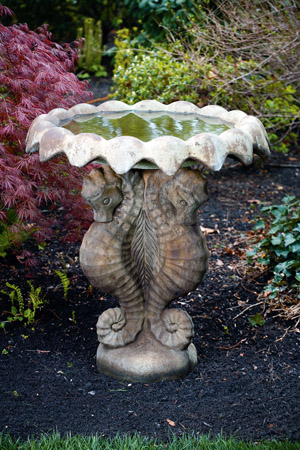
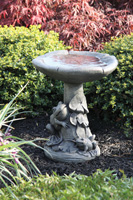
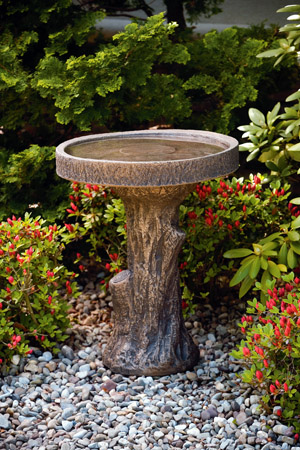
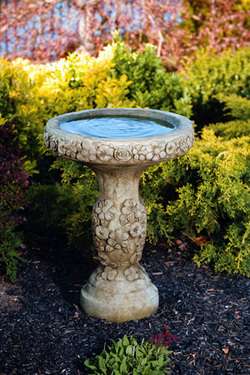
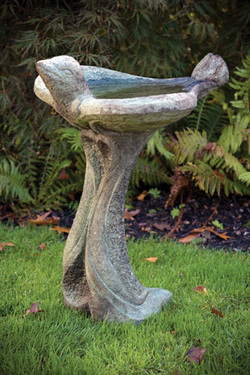
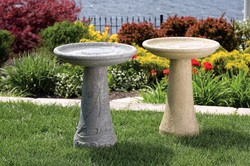
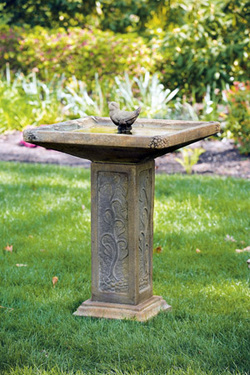
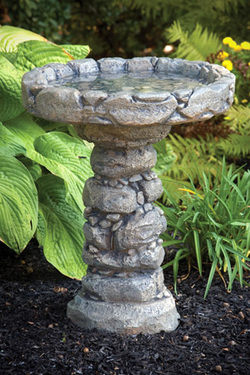
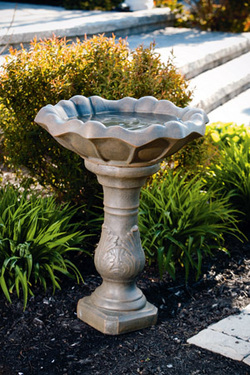
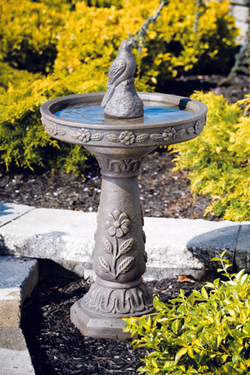
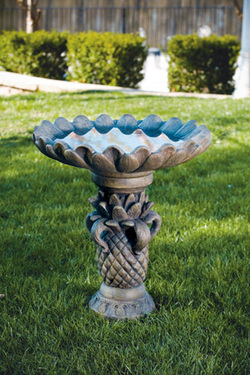
 RSS Feed
RSS Feed

